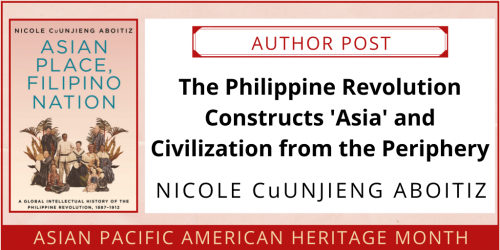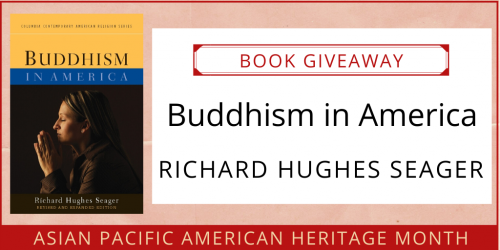Richard Hughes Seager on Buddhism in America

“This well-informed book provides a comprehensive survey of a variety of Buddhist traditions in the contemporary U.S. . . . [Its] strength, apart from being a mine of information, is Seager’s insistence on taking a historically informed and comparative perspective.”
~Religious Studies Review
Our celebration of Asian Pacific American Heritage Month continues today with this guest post by Richard Hughes Seager, author of Buddhism in America, in which he discusses the shifts in American Buddhism.
Enter our drawing for a chance to win a free copy of this book!
• • • • • •
Buddhism in America was first published in 1999, when the religion enjoyed a widespread vogue and the press routinely covered public appearances by the Dalai Lama. Drawn by this attention, scholars of religion, some Asian Buddhism specialists, and Americanists focused on new religious movements began to study the phenomenon. Given their academic training, Buddhologists tended to see emergent American Buddhism as a New World offshoot of regional and national Asian traditions. In contrast, Americanists tended to relate it to romanticism, alternative spirituality, and New Age movements. Between these scholarly communities, a great deal of new territory was explored and a few foundational concepts were delineated, among them the idea that there were two distinctly different forms of American Buddhism. The first, “immigrant Buddhism,” was tied to Buddhist immigration to the United States from various parts of Asia. This had burgeoned after immigration reforms in the mid-sixties but had important nineteenth-century antecedents. The second, “convert Buddhism,” consisted largely of Euro-American seekers with spiritual aspirations and grew out of the Beat-Hip movements of the fifties and sixties. By the 1990s, researchers could observe both groups laying institutional foundations and articulating ways to be Buddhist in this country. However, the two populations remained distinct in their approaches to building traditions, and spirited debates ensued over which represented the most authentic expression of American Buddhism.
“Differentiating two broad Buddhist groups provides an instructive way to consider the scope, depth, and richness of Buddhism as an element in America’s Asian Pacific heritage.”
Differentiating two broad Buddhist groups provides an instructive way to consider the scope, depth, and richness of Buddhism as an element in America’s Asian Pacific heritage. On the one hand, immigrant Buddhists illustrate how Asian Pacific peoples have made extensive contributions to the United States through the time-honored dynamics of immigration. From Chinese and Japanese who built temples in the nineteenth century to more recent arrivals from East, Southeast, and South Asia, immigrant Buddhists represent a process of transplantation, institution building, and adaptation that has played a central role in reconfiguring the United States in the past. Most familiar are the great migrations of European Catholics and Jews in the nineteenth and twentieth centuries, which not only reshaped the American religious landscape but also transformed its politics, intellectual life, cuisine, and artistic expression. In comparable ways, immigrant Buddhist communities established in the twentieth century are now deeply engaged in adding Asian Pacific dimensions to the American experience. The endeavors of the second, third, and fourth generations are conspicuous, in the professions, in politics, in social activist movements, and in cultural production in ways too varied and numerous to enumerate here.
On the other hand, the old convert communities—who have by now also produced a number of Buddhist generations—illustrate Asian Pacific heritage influencing the national culture in more indirect ways. Scholars can now chart how Buddhism and other Asian religions have been filtering into Western culture since the Renaissance and Enlightenment in Europe and at least since the revolution in the United States. The Buddhist boom in the nineties had many antecedents, and researchers have unearthed forgotten pioneers who tied Buddhism to alternative spiritual movements, literary and visual arts, and scientific theories. As important here, those beginnings also led to the establishment of numerous practice communities that fostered the broad dissemination of Buddhism and Buddhist-like ideas throughout American culture, a trend most prominent today in the mindfulness movement influential in medical, educational, business, and artistic endeavors and institutions.
“The Buddhist boom in the nineties had many antecedents, and researchers have unearthed forgotten pioneers who tied Buddhism to alternative spiritual movements, literary and visual arts, and scientific theories.”
The idea that emergent American Buddhism came in two basic kinds was very much in the air when I set to work researching the book. But as I visited centers from New York to Los Angeles, pored over dharma raps from prominent teachers, and made numerous cold calls to informed leaders, it became apparent that there were numerous Buddhisms taking root in this country. Asian Pacific and American heritages could be observed fusing in Sri Lankan and Thai immigrant temples and in Vietnamese and Burmese refugee centers from coastal California to Chicago, Boston, and Gulf Coast Texas. Elders in each tradition were eager to be interviewed about their efforts to build Buddhist communities and their hopes for Buddhist children and grandchildren. Quite different expressions of Asian Pacific heritage could be seen among the numerous native-born practitioners, who were equally eager to talk about their revered teachers, many of them Asian immigrants and refugees; their use of Buddhist symbols and parables; and their debates over how to reinterpret traditional Asian practices in ways best suited to the United States.
Looking back, I am struck by how fortunate I was to have had the opportunity to watch firsthand the astonishingly rich historical processes by which ancient Buddhist traditions began to take root in the United States. A major challenge was to devise a way to sweep all this into a narrative that could make some sense of it. Eventually I settled on chapters devoted to major traditions—each having their own Asian background, modern experience, and style of practice and teaching—with particular attention to how their transplantation was proceeding. I devoted other chapters to special issues under debate within communities related to gender, social activism, and the challenge to maintain practice integrity in a wholly new environment. To my great pleasure, the 1999 edition was well received, critics appreciating it as a kind of road map to an unexpectedly complex Buddhist landscape. It made clear that the question—What is American Buddhism?—needs to be framed to bring out the plural. How do you practice? What is your lineage? Where are your people from? What’s your ethnicity? One critic noted that the chapter “Other Pacific Migrations” gave short shrift to developments among Chinese, Korean, and Vietnamese Buddhists, which I readily admit were beyond my capacity to research and narrate adequately. In recent decades, new monographs have discussed Buddhist immigrant experiences in the more highly articulated terms they require and deserve.
“But as I visited centers from New York to Los Angeles, pored over dharma raps from prominent teachers, and made numerous cold calls to informed leaders, it became apparent that there were numerous Buddhisms taking root in this country.”
About a decade after the book’s publication, Columbia University Press suggested a second edition, published in 2012. As the basic contours of American Buddhism had not significantly changed, we opted for four section introductions to update developments. Some pioneering teachers had died or retired, calling the future of landmark organizations into question. There were succession issues and practice controversies. But most conspicuous was a sense of maturation in both immigrant and Euro-American communities, a sense that the astonishing newness of it all, which had once captured so much attention, had begun to settle into the workaday. A major piece of this can be attributed to second and third generations coming of age in both communities, which shared a taken-for-grantedness about American Buddhism and had new ideas about how it might best proceed. Another factor is that the extraordinary vogue experienced by Buddhism at the end of the twentieth century was eclipsed by a similar vogue for yoga at the opening of the twenty-first. Another complex expression of Asian Pacific heritage! That said, one can still read Buddhism in America to get a sense of the energy, freshness, and excitement of an era when Buddhism was, in many different ways, being developed into a very important part of Asian Pacific heritage in this country.








